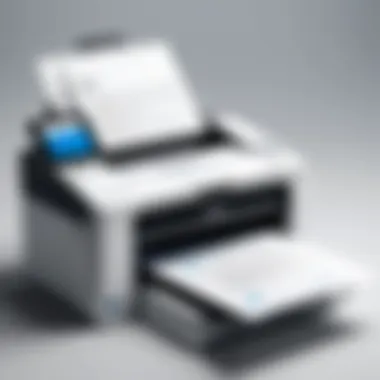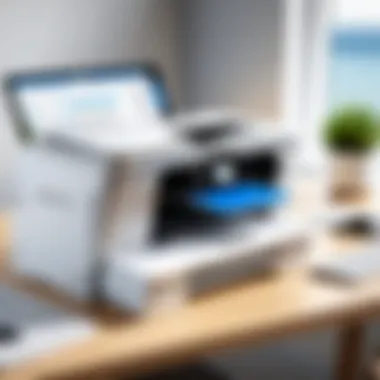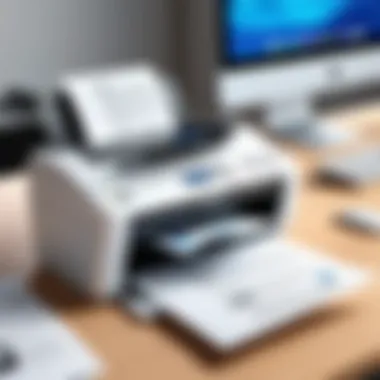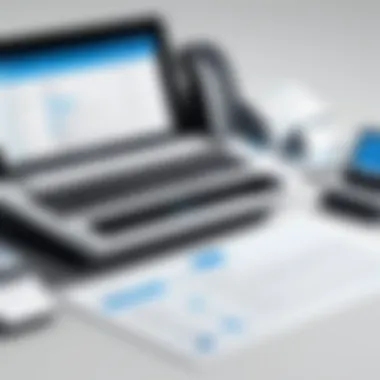Send Email as Fax with Outlook: Step-by-Step Guide


Intro
In today's digital world, the integration of various communication methods is crucial for efficiency. One such integration is the ability to send an email as a fax using Microsoft Outlook. This process can streamline operations for many businesses and professionals, ensuring timely transmission of documents while taking advantage of email's convenience. This guide aims to provide a thorough understanding of how to achieve this, fostering better communication and collaboration.
Hardware Overview
Using Microsoft Outlook to send faxes requires some basic hardware considerations. Below are important aspects to keep in mind:
Specifications
- Fax Machine/Service: A connected fax machine or a cloud-based fax service is essential. Companies like eFax or MyFax offer online solutions that bridge emails and fax systems.
- Modem: For direct faxing from a computer, a modem that supports fax capabilities can be necessary. Ensure your modem is compatible with existing communication systems.
- Computer Specifications: Sufficient RAM and processing power will enhance performance, especially when handling larger documents.
Performance Metrics
Effective performance is measured through the following:
- Transmission Speed: The time taken to send a fax is critical. Network speed and fax hardware impact this metric significantly.
- Quality of Transmission: The clarity of the received document should be high, which may depend on the settings of both the sending and receiving devices.
- Success Rate: Monitor the balance between sent faxes and successful transmissions to understand reliability.
"The efficiency of communication technologies is often gauged by their performance metrics and the user satisfaction they bring."
Software Analysis
To send an email as a fax, various software tools can assist. Understanding features and interfaces is pivotal for effective use.
Features and Functionality
Outlook provides several functionalities that can streamline the faxing process:
- Integration with Online Fax Services: Services like RingCentral and Fax.Plus can integrate directly with Outlook, allowing seamless fax dispatch.
- Attachments and Formatting: Enables users to attach documents directly from email. Ensuring that the document format is compatible, usually PDF or DOCX, is crucial.
- Address Book Access: Often, you can save and access contacts directly within Outlook, making it easier to manage recipients.
User Interface and Experience
The user interface of Outlook is generally user-friendly. Here are key aspects that contribute to the experience:
- Ease of Navigation: Users can easily find options to send faxes from the ribbon menu or through additional tools.
- Customization Options: Ability to customize fax cover pages and settings enhances the professional appearance of the communication. The flexibility to edit makes it user-friendly.
Finale
Sending an email as a fax using Outlook can be a valuable skill. This guide details the necessary components, software capabilities, and how you can enhance communication in any professional setting. Mastering this integration not only fosters efficiency but also promotes better resource management in workflows.
Intro to Email as Fax
The integration of email and faxing methods represents a significant step in modern communication. As businesses evolve, the need to streamline processes becomes paramount. Emailing documents directly as faxes facilitates faster, more efficient communication. It reduces the reliance on traditional telecommunication methods that can be slow and cumbersome.
Using Outlook to send faxes electronically not only enhances productivity but also ensures that important documents reach their destinations without delays or errors. Understanding how to leverage these capabilities in Outlook can lead to considerable time savings and cost reductions.
Understanding the Need for Faxing via Email
In a world where digital communication is rapidly replacing traditional methods, the facet of faxing remains relevant, especially in industries that maintain strict compliance standards. Faxing via email offers several key advantages:
- Time Efficiency: The process of sending a fax through email is swifter. Documents can be sent instantly without printing or manual transmission.
- Cost-Effectiveness: Eliminating the need for a dedicated fax machine reduces expenses associated with paper and ink.
- Record Keeping: Digital records are easier to organize and store compared to physical copies, which are prone to physical damage.
The necessity arises when organizations need to ensure the uninterrupted flow of sensitive and legally binding documentation while adhering to compliance mandates that include traditional fax signatures.
Overview of Microsoft Outlook's Capabilities
Microsoft Outlook, a robust email client, serves as an essential tool for business communications. Beyond standard emailing functionalities, Outlook possesses unique capabilities that make it ideal for sending faxes.
- User-Friendly Interface: The structured layout of Outlook enables users to navigate its features with ease, making the faxing process straightforward.
- Integration with Fax Services: Outlook allows for extension through third-party fax service integrations. This enables the seamless sending of documents as faxes directly from one’s email account.
- Comprehensive Management: Users can track sent faxes within their email, ensuring that all communications are centralized and manageable.


In summary, understanding the need for transmitting faxes via email combined with Outlook's capabilities creates a compelling case for its use in contemporary business environments.
Prerequisites for Sending Email as Fax
Sending an email as a fax combines traditional communication with modern technology. Understanding the prerequisites for this process is essential for a smooth and effective execution. This section will outline the crucial elements needed to facilitate the email to fax transition successfully.
Required Hardware and Software
To send an email as a fax using Outlook, specific hardware and software are required.
- Computer: A desktop or laptop with an operating system compatible with Outlook is essential. Windows and Mac systems are widely used and supported.
- Microsoft Outlook: Ensure you have the latest version of Outlook installed. Compatibility with email protocols is necessary for the integration process.
- Fax Service: You will need a third-party fax service provider, such as eFax or RingCentral. These services allow you to convert emails into faxes effectively.
- Internet Connection: A reliable internet connection is vital. Without it, the transmission of the email to fax will not occur.
- Optional Fax Machine: While not necessary, having a physical fax machine can be useful. Some providers support direct sending to fax machines as part of their services.
Necessary Configuration Settings
Proper configuration settings are critical for ensuring seamless communication between email and fax services. Here are key considerations:
- Email Account Configuration: You need to set up your email account in Outlook. Make sure the account settings are correct and functional, including SMTP settings for sending emails.
- Fax Service Setup: After choosing your fax service provider, follow their specific setup instructions. This often includes creating an account and configuring email settings provided by them.
- Templates: Prepare templates for fax cover pages or common fax documents. This can streamline the process and reduce time spent on composing new faxes each time.
- Testing the Configuration: Before sending important faxes, test the configuration by sending a test fax to ensure everything is set up correctly. It helps identify any issues that may hinder future communications.
The effective sending of emails as faxes through Outlook requires a blend of the right hardware, software, and configurations. Careful attention to these details can significantly enhance the efficiency of this communication method.
Setting Up a Fax Service in Outlook
Setting up a fax service in Microsoft Outlook is a crucial step in facilitating the seamless integration of email and fax technologies. This setup allows users to send faxes directly from their email account, enhancing workflow efficiency and reducing the reliance on traditional fax machines. The benefits of this integration are manifold, ranging from saving time to improving record keeping. However, careful consideration of the right provider and proper integration methods is essential to achieve optimal results.
Choosing the Right Fax Service Provider
Selecting a reliable fax service provider is the first step in your fax integration journey. Not all providers offer the same features or level of reliability. When evaluating potential options, consider the following elements:
- Reputation: Research the provider’s track record in reliability and customer service. Look for user reviews on sites like reddit.com or facebook.com.
- Features: Some providers include features like electronic signatures, cloud storage access, and multiple user accounts. Determine which features play a crucial role in your organization’s faxing needs.
- Cost: Compare pricing plans. Some services may charge per fax, while others offer subscription models. Assess which option aligns best with your usage frequency.
- Compatibility: Ensure that the chosen service can easily integrate with Microsoft Outlook. Checking for pre-built plugins or add-ons will save time during the setup process.
In this phase, keep your specific faxing needs in mind. A balance between affordability and capabilities is ideal in finding the right provider.
Integrating Fax Service with Outlook
Once you have chosen a provider, integration with Outlook is the next crucial step. Properly integrating the fax service streamlines the process, allowing users to send and receive faxes with minimal friction. Here are key considerations:
- Installation: Follow the service provider’s specific installation instructions. This typically involves downloading a plugin or software that connects Outlook to their fax service.
- Configuration Settings: After installation, you must configure settings within Outlook to recognize the fax service. This often includes entering login credentials and API keys provided by the service.
- Testing: Before relying on the new setup for critical communications, send a test fax to ensure everything is functioning correctly. This verification step can help identify and resolve any initial issues.
Integrating fax services is not merely about installation; it is about creating a cohesive system that enhances communication. By taking the time to initially configure and test the integration, users can reduce the potential for errors in the future.
Important: Always keep your software and integrations updated to maintain compatibility and security.
Establishing this functionality represents a significant step forward in how organizations manage their communications. A well-integrated fax service in Outlook makes for a more efficient operation, ultimately benefiting client interactions and internal processes alike.
Step-by-Step Guide to Send Email as Fax
The process of sending an email as a fax through Microsoft Outlook is straightforward but requires careful attention to detail. This section offers a structured approach to simplify the task. Understanding each step helps ensure successful transmission, minimizes errors, and enhances efficiency in communication.
Creating the Fax Cover Page
The fax cover page serves as the initial point of contact for the recipient. It is crucial to include essential information such as the sender's name, contact details, and any relevant subject line. A well-structured cover page improves professionalism. Additionally, it helps the recipient quickly identify the purpose of the fax. To create a fax cover page in Outlook, follow these steps:
- Open a new Microsoft Word document.
- Use a simple template or create your own layout.
- Include a header with your organization’s name and logo if applicable.
- Add fields for the recipient's information, date, and a brief note if needed.
- Save the document as a PDF; most fax services accept this format.
Verification and Confirmation
In the world of modern communication, verifying and confirming the status of sent faxes through email can greatly enhance the reliability and efficiency of document transmission. This section emphasizes the significance of these processes in ensuring that your faxed documents are received and acknowledged by the recipient. Navigating the intricacies of sending an email as a fax using Microsoft Outlook necessitates a solid understanding of the verification steps involved.
Essentially, verification serves as a mechanism to affirm that the transmission of the fax has been successful, while confirmation deals with ensuring receipt by the intended user. Both elements are essential to maintain a professional standard in business communication, especially for sensitive documents.


Some key benefits of properly verifying and confirming fax transmission include:
- Reduced Miscommunication: By knowing the actual status of the fax, businesses can avoid unnecessary follow-ups and clarify any issues immediately.
- Improved Tracking: Keep a detailed record of fax communications, which can be invaluable for compliance and auditing purposes.
- Increased Trust: Recipients are more likely to trust the sender when they can confirm receipt of important documents.
Considering the nature of document exchanges in various fields, implementing effective verification and confirmation practices can lead to better operational efficiency.
Checking Fax Status
Once an email is sent as a fax from Microsoft Outlook, checking the status of that fax is an essential next step. Most fax service providers offer a way to track the status of faxes within their own interface, which can be accessed through Outlook or directly via their website. Understanding the status of a fax can mean the difference between timely execution of projects and delays that can arise from miscommunications.
To check the status of your recently sent fax, follow these steps:
- Log in to your fax service provider’s portal.
- Navigate to the 'Sent Items' or 'Fax History' section.
- Locate the specific fax you wish to track to view its status. Typical statuses include:
- Sent
- Delivered
- Failed
- Pending
Checking these statuses enables users to act accordingly. If a fax has failed or is pending, measures can be taken to resend it or resolve any underlying issues.
Obtaining Delivery Receipts
Obtaining delivery receipts is a crucial step in the verification process when sending faxes via email. Delivery receipts provide proof that a fax was successfully transmitted and received by the intended recipient. Most modern fax services will automatically generate a delivery receipt that is sent back to the sender's email.
To ensure you receive delivery receipts:
- Make sure to enable this feature during the configuration of your fax services in Outlook.
- Check the settings to ensure that receipt notifications are active and directed to your email address.
- Regularly monitor your inbox for these receipts after sending faxes.
Delivery receipts give you confidence in the communication process and can serve as legal evidence of document transfer if disputes arise regarding sent material. Failure to obtain these receipts can lead to misunderstandings and potential issues, especially in regulatory environments where documented proof is necessary.
"Receiving a delivery receipt is not just a formality; it's an assurance of communication integrity, particularly in sensitive or time-critical situations."
By implementing robust verification and confirmation practices, users can significantly enhance their fax communication workflows, assuring clarity and professionalism in their document management systems.
Troubleshooting Common Issues
The process of sending emails as faxes through Microsoft Outlook is not without its challenges. Understanding how to troubleshoot common issues is vital for IT professionals and tech enthusiasts alike. This section details the common issues that may arise during fax transmission and outlines methods to resolve them effectively. Emphasizing the importance of troubleshooting ensures smoother communication and minimizes disruptions in workflows.
Failed Fax Transmission Errors
Errors during fax transmission can be frustrating. These issues typically manifest when the email fails to reach the intended fax machine. They can arise from various sources, such as incorrect fax numbers or network interruptions. Some signs of failed transmission include not receiving a delivery confirmation or error messages appearing in the email client.
Here are steps to check for and remedy these issues:
- Verify Fax Number: Ensure that the recipient’s fax number is accurately entered. Even a single incorrect digit can result in failure.
- Check Fax Service Status: Services may experience outages. Confirm if the fax service provider is operational.
- Inspect Network Connection: A stable internet connection is necessary for successful transmission. Check if the internet connection is active.
- Review Outgoing Email Settings: Ensure that no filters or blocks are preventing the email from sending.
By systematically checking each of these factors, one can often resolve transmission errors effectively.
Email Configuration Problems
Configuration issues can hinder the ability to send faxes via email. These problems often stem from incorrect setup during the initial integration of fax services with Outlook.
Common configuration problems may include:
- SMTP Settings: Verify that the Simple Mail Transfer Protocol (SMTP) settings are correctly configured. This includes the server address, port number, and security protocols.
- Authentication Issues: Some fax services require specific authentication before transmission. Ensure your credentials are accurate in your email client settings.
- Email Client Updates: Using an outdated version of Outlook can lead to compatibility issues. Always keep your software updated to mitigate these risks.
To address email configuration problems, start with checking SMTP settings and ensuring all documentation for the integration is followed properly. Many service providers offer troubleshooting guides that can provide insight into common settings that need attention.
"A small oversight in configuration can lead to significant communication breakdowns. Always pay close attention to details."
Best Practices for Email to Fax Communication


Ensuring efficient communication requires attention to various factors, particularly when integrating modern technology with traditional methods. Email to fax communication presents unique challenges and opportunities. Emphasizing best practices can significantly enhance the reliability and security of your fax transmissions. Adhering to these standards not only aids in maintaining professionalism but also assists in preventing errors that could lead to lost or misdirected information.
There are essential guidelines one should consider to streamline the email to fax process effectively. Implementing these practices ensures a smooth flow of information between all parties involved.
Ensuring Compliance and Security
In the digital age, compliance with legal and regulatory standards is paramount. When sending sensitive information via email as fax, ensuring security becomes a top priority. Compliance entails recognizing the governing laws surrounding data privacy and protection, such as the Health Insurance Portability and Accountability Act (HIPAA) for healthcare information or the General Data Protection Regulation (GDPR) for European citizens. These regulations specify how data should be handled to protect individual privacy.
Key considerations include:
- Use of Encrypted Networks: Always use secure connections, like Virtual Private Networks (VPNs), when sending sensitive information. This adds a layer of protection against interception.
- Authentication Measures: Implement strong password protocols and two-factor authentication to safeguard your fax service accounts from unauthorized access.
- Audit Trails: Keep records of all sent faxes, noting details such as time, date, and recipient. This is critical for compliance audits and tracking.
Compliance is not an option; it is a necessity to protect your organization's integrity and customer trust.
Organizing Fax Records and Documentation
Organizing fax records systematically is crucial in any business setting. An orderly approach aids in retrieval and ensures accountability. Establishing a consistent method for managing sent and received faxes should begin with a clear filing structure. Here are some strategies:
- Digital Storage Solutions: Utilize cloud-based storage systems to keep your fax documents easily accessible and sharable among authorized personnel. Popular services include Google Drive and Dropbox.
- Consistent Naming Conventions: Create a distict naming system for documents. Include relevant information such as the sender's name, recipient's name, and the date. This will simplify searches through your records later.
- Regular Backups: Schedule routine backups of your fax documents, ensuring you have copies even in the case of data loss due to technical failures.
Maintaining proper documentation enhances productivity and helps in addressing legal inquiries or disputes. An organized archive not only streamlines business operations but also instills confidence in your communication practices.
Alternatives to Email Faxing
In the era of digital communication, there are several alternatives to traditional methods of sending faxes via email. Understanding these alternatives is crucial for individuals and organizations aiming to optimize their communication strategies. These options offer different benefits and considerations that can align better with specific needs. This section delves into two primary alternatives: dedicated fax software solutions and online fax services.
Dedicated Fax Software Solutions
Dedicated fax software provides a robust alternative for those who frequently need to send and receive faxes. These programs often come with advanced features that facilitate not just faxing, but also integrate well with other office applications. Several key benefits of using dedicated fax software include:
- Scalability: Such solutions often accommodate various organizational sizes. They can handle high volumes of faxes, which is beneficial for businesses that require swift document transmission.
- Integration: Many dedicated fax software solutions allow seamless integration with productivity programs like Microsoft Word and Excel. This enables users to send faxes directly from these applications, streamlining the workflow.
- Security: Security is a priority for many organizations. Dedicated fax software often provides enhanced security features such as encryption and user authentication, ensuring that sensitive documents are protected during transmission.
Some popular dedicated fax software options include eFax, Rentafax, and CocoFax. Each offers unique features that cater to different user requirements.
Online Fax Services
Online fax services represent another viable alternative to the traditional faxing methods. They are cloud-based services that allow users to send and receive faxes via the internet. The growing trend of remote work has propelled the use of these services. Here are some significant considerations:
- Ease of Use: Online fax services typically have user-friendly interfaces. Users can send faxes instantly through an online portal, without the need for software installation.
- Cost-Effectiveness: Many online fax services operate on a subscription model, which can be more economical compared to maintaining dedicated fax lines or purchasing software licenses. Users can choose plans that suit their faxing needs, sometimes even offering pay-per-fax options.
- Accessibility: With internet access, users can send faxes from anywhere in the world, enhancing flexibility and convenience. This is particularly beneficial for remote teams or businesses with employees in different locations.
Popular online fax services include FaxZero, MyFax, and HelloFax. These services stand out due to their easy setup and reliable performance.
Choosing the right alternative to email faxing depends on specific needs such as volume, security requirements, and ease of use. Evaluating these factors will help determine the best fit for individuals or organizations.
Finale
In summation, understanding the intricacies of sending email as fax using Outlook is vital for efficient communication in today’s tech-driven environment. This article elucidates the process and offers a guide that balances functionality with technicalities, ensuring that both IT professionals and tech enthusiasts can navigate it with ease.
Summary of Key Points
The key points discussed throughout this guide include:
- Understanding the necessity behind converting emails to faxes, especially in professional settings where document security and authenticity are paramount.
- Identifying the prerequisites, such as hardware and software requirements, that enable seamless fax delivery through email.
- Providing a detailed, step-by-step process that includes creating a fax cover page, composing messages, and selecting recipient fax numbers effectively.
- Discussing common issues that users may face and offering troubleshooting advice to mitigate these problems.
- Presenting best practices to maintain compliance and documentation across electronic communications.
This synthesis highlights how the combination of email and fax technology not only preserves traditional methods of communication but also enhances efficiency.
Future of Email and Fax Integration
Looking forward, the integration of email and fax technologies is poised for continuing innovation. The increasing prevalence of cloud services presents opportunities for further advancements in how these systems interact. Organizations are expected to demand more streamlined processes, minimizing the need for physical fax machines while enhancing digital security measures.
Furthermore, excelling in this realm includes understanding emerging technologies like artificial intelligence. These technologies can be harnessed to automate fax processes and improve user experience in management of communications. As IT infrastructures evolve, one can anticipate that the seamless blending of these platforms will become not just preferred but essential.
"Efficient integration of communication tools enhances productivity and fosters a collaborative environment in any organization".
Overall, the future of email to fax transmission suggests a promising paradigm shift where traditional methods will coexist with technology-driven solutions for professional communication.



